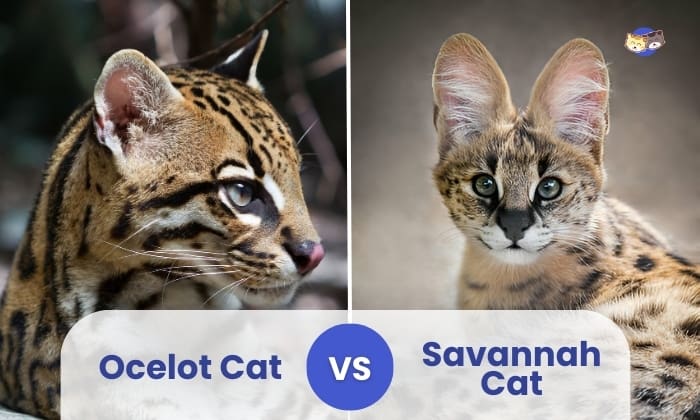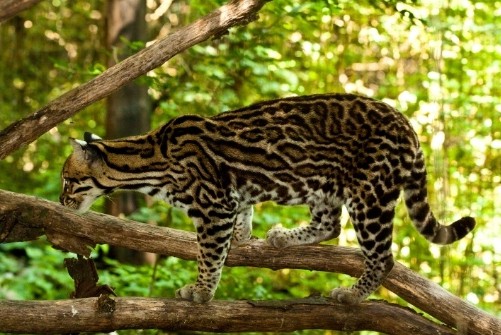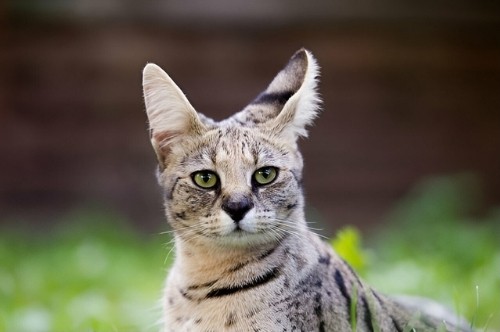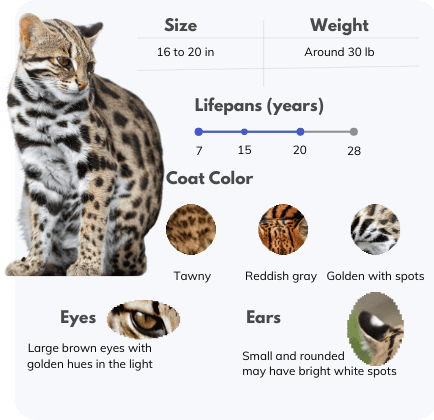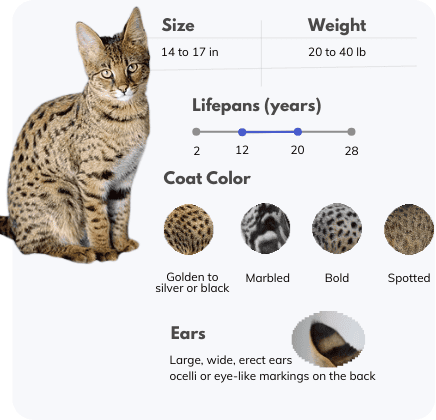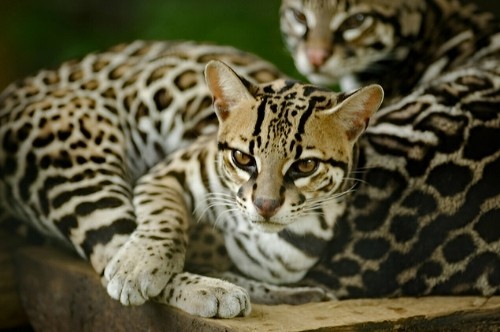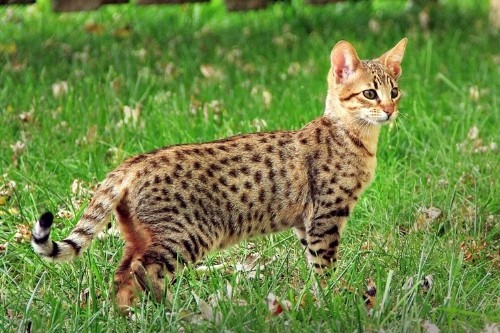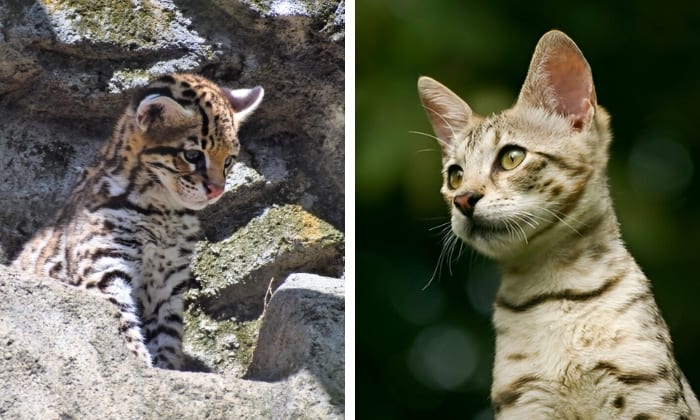Ocelots and Savannah cats may seem identical at a glance due to their coat patterns, fur colors, and disposition.
However, they are completely different breeds. These felines have highly distinctive features within their trainability and adaptability to the environment, mainly because of their origin.
The Ocelot is a wild cat living throughout the Central and Northern parts of South America, whereas the Savannah is a hybrid cat breed of an African serval and a Siamese domestic cat.
In this article, we will compare Ocelot vs Savannah Cat and dig deeper into their differences.
| Categories | Ocelot | Savannah Cat |
| Average Height | 16 to 20 inches tall | 14 to 17 inches tall |
| Average Weight | Around 30 pounds | Between 20 to 40 pounds |
| Lifespan | 7 to 20 years | 12 to 20 years |
| Socialization with Other Pets | Very territorial and not friendly with other pets | Can be friendly to other pets like dogs or cats |
| Exercise | Requires safe and secure spacious areas for daily exercise activities | Requires safe and secure spacious areas for daily exercise activities |
| Care | Solitary but should be provided with lots of attention when kept in captivity | Requires a lot of attention |
| Trainability | Very difficult | Clever and can be responsive to basic commands, but stubborn |
| Family-friendly | NO | YES |
| Grooming | Minimal | Minimal |
Table of Contents
Ocelot vs Savannah Cat: A Detailed Comparison
1. Origin
Ocelot
The Ocelot is thought to have diverged from the margay, a wild cat from the Felidae family. Ocelots have been living throughout the vast rainforests of South America, ranging from southern Texas to northern Argentina.
It is also native to southwestern US, Mexico, and the Caribbean islands.
Savannah Cat
The Savannah Cat is a crossbreed of an African serval cat and a Siamese domestic cat, emerging in the United States in 1986. Savannahs are categorized by filial generation numbers, ranging from F1 to F8.
F1 Savannahs are the direct offspring of a serval and domestic cat, making their serval ancestry dominant. Thus, they tend to possess wild cat traits, which may require special handling and care.
Further generations (higher filial numbers) make Savannahs more domesticated and better suited as pets.
2. Appearance
Ocelot
Ocelots are medium-sized wild cats that exhibit beautiful tawny, reddish gray, or golden coats with patterns and spots akin to jaguars and tigers (dark stripes, horizontal streaks, and white spots).
They usually weigh around 30 pounds and have a body length that can grow up to 2 to 3 feet. Ocelots also stand about 16 to 20 inches tall, and they are relatively smaller than other wild cats.
They have small rounded ears that often sport bright white spots. Their large brown eyes give off golden hues when reflected against the light.
Savannah Cat
Savannah cats have coats that vary from golden to silver or even black, splashed with bold, spotted, or marbled patterns similar to those of the serval. They have a lean, muscular build, and usually weigh between 20 to 40 pounds.
One of their distinct physical traits is their large, wide, erect ears that often feature unique ocelli or eye-like markings on the back.
Known to be among large domestic cat size breeds, Savannahs have very long legs and long necks, and can measure between 14 to 17 inches tall.
3. Personality and Trainability
Ocelot
Ocelots may possess mischievous traits and exhibit destructive behavior such as clawing furniture, scratching the walls, or tearing things apart. They also love to hang out in high places and climb walls, sometimes causing fragile household items to fall and break.
Ocelots are mostly nocturnal and solitary. Since they are very territorial, they often mark territories with their urine and may even get into a fierce cat fight to defend their territories.
Savannah Cat
Savannah cats are sociable, playful, and friendly because of their affectionate and outgoing personality. Known for their intelligence, these cats tend to be active and curious.
They are excellent jumpers and can go as high as 8 feet! That’s why you may find them at high places like your kitchen countertops, cabinets, or refrigerators.
Although both breeds are active and sociable, Ocelots are more difficult and challenging to train, primarily because they are not domesticated, unlike Savannahs.
You might even need assistance from professional exotic animal trainers to help you tame one. But even with training, Ocelots won’t easily depart from their innate instincts.
4. Grooming and Hygiene
Ocelots require regular grooming, including nail trimming every two weeks or when necessary.
In comparison, Savannah cats have short coarse coats that do not require frequent brushing. Once a week will do. Weekly teeth brushing and nail trimming every one or two weeks should also be part of their grooming routine.
5. Exercise
Both Savannah and Ocelot cats are active and do not fear water. Providing ample stimulation activities and physical exercises can keep their behavioral issues at bay. A vast but secure outdoor space is worth considering for owners of these felines.
6. Companion Suitability
Ocelot
Although they may display tolerance and curiosity toward humans, Ocelots don’t show affection as domesticated cats do.
Being wild cats, they live in solitariness and possess behaviors more rooted in their innate wild instincts. Avoid introducing them to other pets, as their desire for hunting will never go away.
Savannah Cat
Savannahs are domesticated cats and can be loving toward humans. They can show affection and are known to follow their humans around. If you have other pets like a dog or cat, they can also learn to adapt to living with them.
But take note that supervised interactions are very important, at least for the first few weeks.
7. Legal Issues
Since both breeds are considered exotic animals, acquiring a Savannah cat or an Ocelot won’t be easy. It is a prerequisite to check whether it is legal to own either of these breeds in your state or country.
Some local governments may require permits and have specific regulations with regard to owning an exotic animal (such as permitting later generations but not earlier ones), while some areas explicitly prohibit them.
Which Exotic Cat is Best Suited for Your Home?
After a thorough study about Savannah Cat vs Ocelot, it all goes down to one question: which breed makes a great pet for your home?
Both breeds present challenges in terms of care and training. However, Ocelots are more inclined to their strong innate instincts, making them better suited for the wild rather than life in captivity or as pets.
Savannah cats, meanwhile, are clever felines that can adapt well to living with humans and other pets. They can be affectionate and form strong bonds with their humans, making them more suitable as house cats.
Conclusion
In this in-depth comparative review of Ocelot vs Savannah cat, we have learned the significant characteristics of these breeds that make them stand out in the feline world.
Overall, their personalities reveal that Ocelots don’t make good pets, unlike Savannahs.
Although owning an exotic cat may seem interesting, in real life, keeping either a Savannah or Ocelot as a pet can be life-changing. These breeds will require more than just your usual routine with domestic house cats; they should be provided with special care and attention.
Related:

I pursued veterinary studies at the University of Kansas. After several years of practice, I established a veterinary clinic in Kansas. When Michael extended an invitation with a vision that went beyond emergency support – sharing of caregiving information for guardians to create the best living environment for cats, I didn’t hesitate to join the organization.
My role here involves verifying the information presented on the official website. With my experience, I believe the information provided is entirely accurate. If you have any concerns, please feel free to reach out to me


